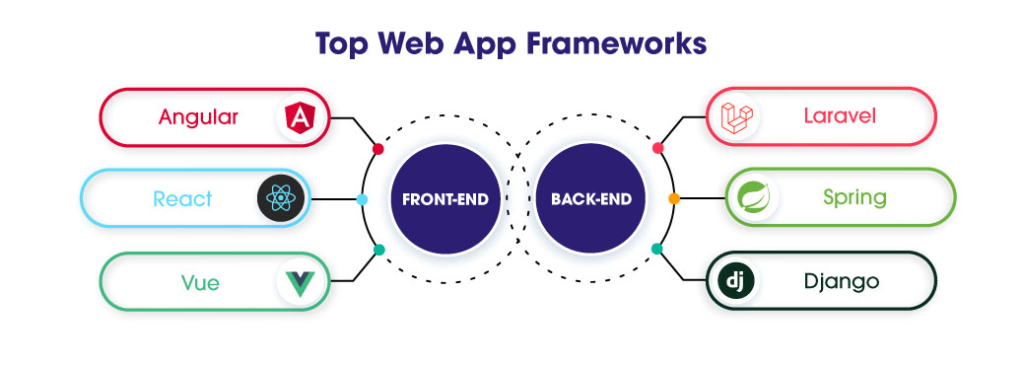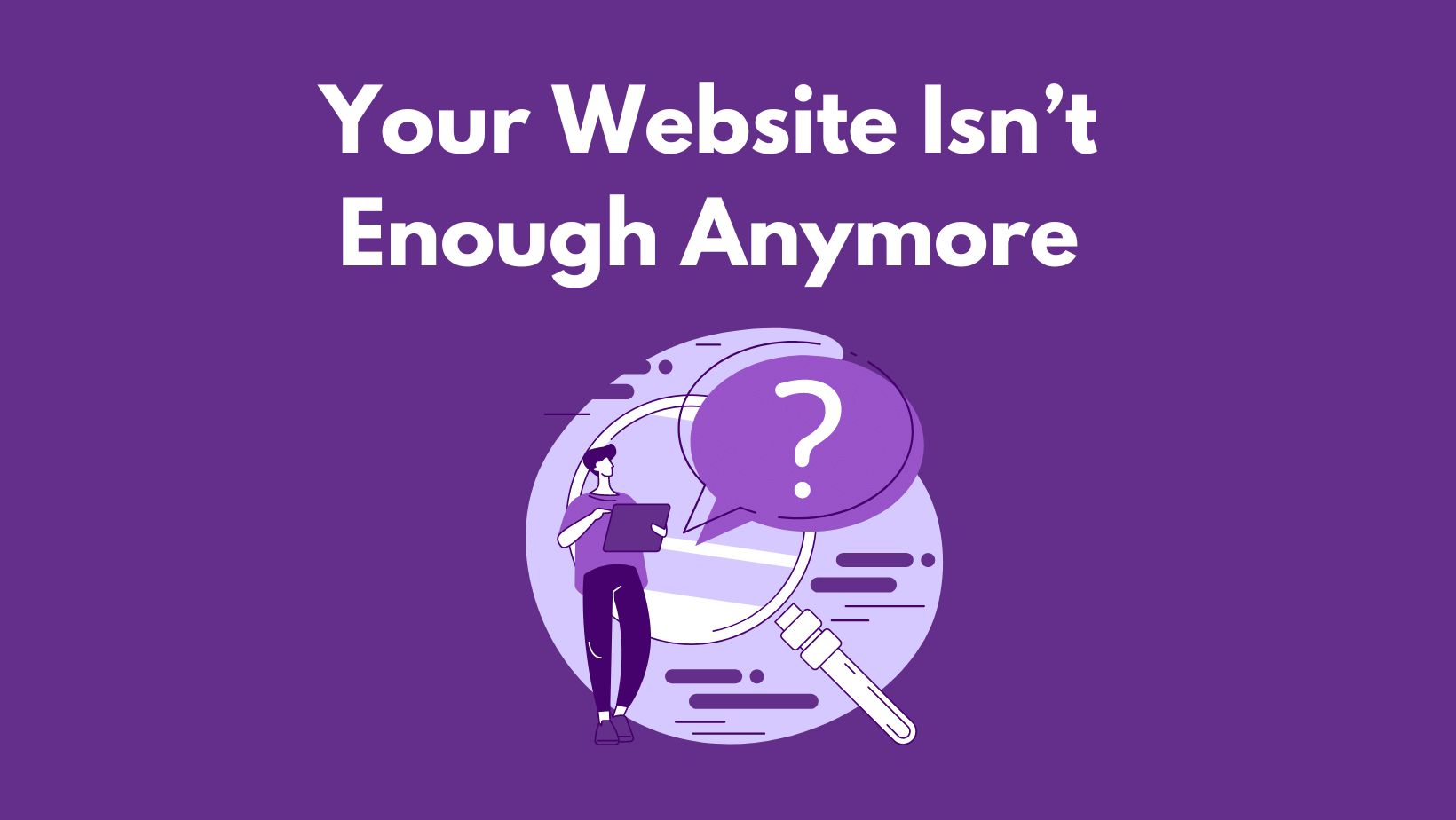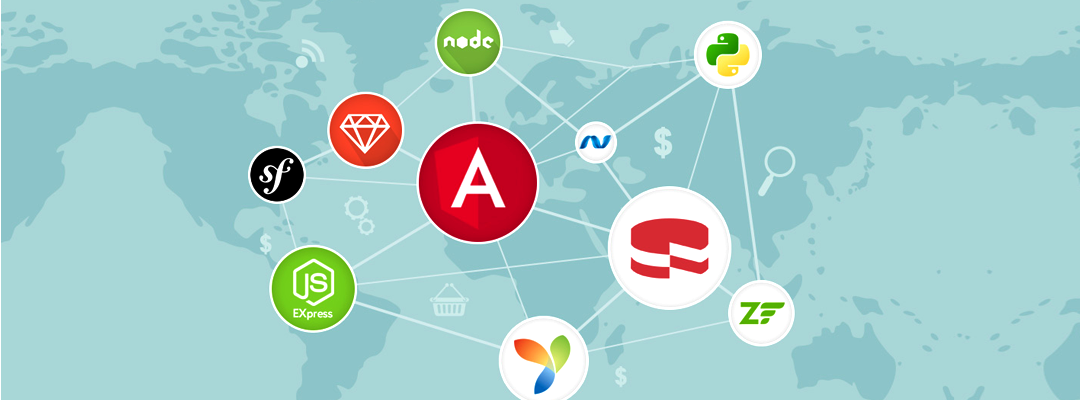The requirement for teams to quickly provide custom software that can be scaled and evolved to meet client needs has never been greater as application development continues to change. You need to up your business game with intuitive web application design and development if you want to engage, attract, and convert potential visitors into customers. A web application framework is one of the tools that can, thankfully, make the development of web applications simpler.
So, the question is, how do you pick the best framework for web app development? According to our observations and experiences, these are the top frameworks used by development teams and other information you should be aware of. The question of the finest frontend vs. backend frameworks is essential since the web app performance will be based on the tech you choose for both aspects.
Frameworks For the Front-End and Back-End
A web-based product’s back-end (server-side) part manages its internal operations, while the front-end, or client-side, part manages user interactions with it. Together, they construct a fully functional web application. The most popular web app frameworks are split into two groups based on that classification.

Frontend Frameworks
The front-end portion of a web application can be created using front-end development frameworks, which offer a prewritten structure. They set up the data flow based on user input, structure the functionality, and manage user engagement as well as style elements. Front-end frameworks are therefore used to design user-friendly interfaces and quickly find, organize, and update data obtained from a server or API. Front-end frameworks’ underlying technologies are HTML, CSS, and JavaScript. Some of the frameworks that are most in demand are React, Vue and Angular.
A frontend web app framework will produce the right face for your projects so your users can get a sense of your brand through engagement, so it’s necessary to pick the right one. Let’s go into more detail about some of the best web app frameworks.
1. React
React should be included in the most widely used web development frameworks list. Although technically speaking, it is not a web app framework; many developers know its ability to build component-based apps. Our business is not an exception because we frequently actively employ React for web development.
React may be used on both the client side and the server side because it is a robust UI library in the first place. This technology is essential for producing engaging user interfaces and component-specific apps that divide the functional design into simple-to-manage pieces. Similar to this, React’s virtual DOM makes it possible to build apps that function normally even under extreme demand.
2. Vue
One of the newest and most promising open-source development frameworks, Vue has strong support from the community. This web app framework has gained widespread adoption because, among other reasons, it is simpler to learn than Angular and has a more lightweight character than React.
3. Angular
Angular is a powerful web development giant that was created in 2010 and completely revamped in 2016. It is an open-source web app framework for development that was converted from JavaScript to TypeScript. This significantly increased the capacity for development and prepared Angular for large-scale Enterprise-grade applications.
The architecture is connected using two-way data binding, which enables dynamic updates to be added to the backend with each user interaction. The framework is a comprehensive choice for cross-platform solutions because tools and packages are available for almost any use case. On the other hand, the Angular web app framework is frequently bigger than other front-end development frameworks, which may impact overall performance.
We’ve already covered the key differences between React, Angular, and Vue, so you can learn more about comparing these well-liked front-end development frameworks.
When you need to develop progressive web applications and SPAs as quickly as possible, it can be challenging to choose the ideal alternative. These responsibilities are handled by Vue thanks to its adaptability, integration-ready components, reactive two-way data flow, and small by default size.
Backend Frameworks
The best frameworks for web apps offer a foundation for delivering an application’s server-side architecture. They take care of all database and server operations, build URL mapping, and put the necessary structures in place to carry out the intricate details of business logic. A back-end developer oversees effective communication between the various services that make up a fully-functional online application while keeping an eye on user involvement. Back-end frameworks’ foundational technologies are Python, JavaScript, PHP, and Ruby. The frameworks most in demand are Django, Spring, and Laravel.
Let’s get into more detail about some of the top backend frameworks to build web apps with smooth inner workings and easy fixability.
1. Django
The python-based open-source project, Django, includes JavaScript code in several apps. This web app framework was first introduced in 2005 and has since been developed and improved, emphasizing scalability, performance, and cybersecurity. Due to its excellent support for the most common database back-ends and its wide range of out-of-the-box features, developers can use it.
Since Django is built on “Convention Over Configuration” and the DRY (don’t repeat yourself) patterns, applications built with it launch more quickly than those built with other web development frameworks. The maximum development speed of Django has already been used by many well-known brands, including Instagram and Google Development, to publish their apps.
2. Spring
Another deserving open-source mention on our list is Spring. It offers support for Java programs with straightforward logic and quick execution. The popularity of this web app framework began to soar with the advent of the Enterprise JavaBeans (EJB) model for various reasons. It first aids in building a strong framework for developing enterprise-grade apps. It also uses a potent extension suite and a POJO-based programming model.
Aspect-Oriented programming, dependency injection, and strong modularity are some of the other potent aspects that allow Spring to promote decoupling and provide reliable code for high-performing programs. It is important to note that web development frameworks typically have a modest file size, which makes Spring transparent and lightweight.
3. Laravel
Due to the clear syntax and robust ecosystem of learning resources, Laravel is a PHP-enabled web app framework with a low learning curve. It has a ton of pre-installed packages that expand its capability, as well as built-in API compatibility.
Laravel might not exhibit the same level of performance as Express or the Python/Django bundle when it comes to huge Enterprise-level apps. But Laravel can outperform its rivals and complete the required features more quickly if the project calls for non-trivial logic.
How To Select the Right Framework
It’s important to comprehend a number of things before choosing a framework, such as the necessary functionality, the community, and the described code. Additionally, many specific demands go unmet. Namely:
– The necessity of hosting; Django and Ruby on Rails are appropriate for unconventional environments. Developers need to know whether the framework needs a specific host for the application or if it may run on any host.
– Efficient installation; The key benefit of the framework is simplification, thus complicated installation is not preferred because it lengthens the deployment time. Some varieties will just need two or three little tweaks.
– Main library of code; The framework library has to facilitate substitution with other elements and contain all relevant functionality.
– Module evaluation; Testing of this kind is essential for any adjustments made during development or maintenance, and it’s required for productivity. The frameworks that the developers find must either have fundamental testing or facilitate the creation of user tests.
– Licenses; While certain frameworks are unsuitable for business programs, many of them have unrestricted permissions.
Frameworks handle the complicated and time-consuming labor by offering tested plugins, templates, and other features. They enable the management of files, the use of authentication, and the rapid and easy extension of application functionality by programmers.
The backend framework can help programmers work more productively, hasten the process of launching a new application, and transform the web development industry. In 2023, there will be a wide range of options, and everyone will be able to select the right tool that fully complies with the project’s functioning.
Conclusion
Don’t be afraid to start working on a web app framework. It will offer you a better understanding of how to accomplish tasks. You’ll find that frameworks, even those from the same category but written in different languages, share many similarities. Remember that major corporations frequently migrate and experiment with new ideas, proving that there is no such thing as a dead end. If you’re looking to build a scalable web app, then Golpik Inc. has got you covered with all the right resources. Whether it’s maintenance and support or complete development from scratch, our experts will handle it!








